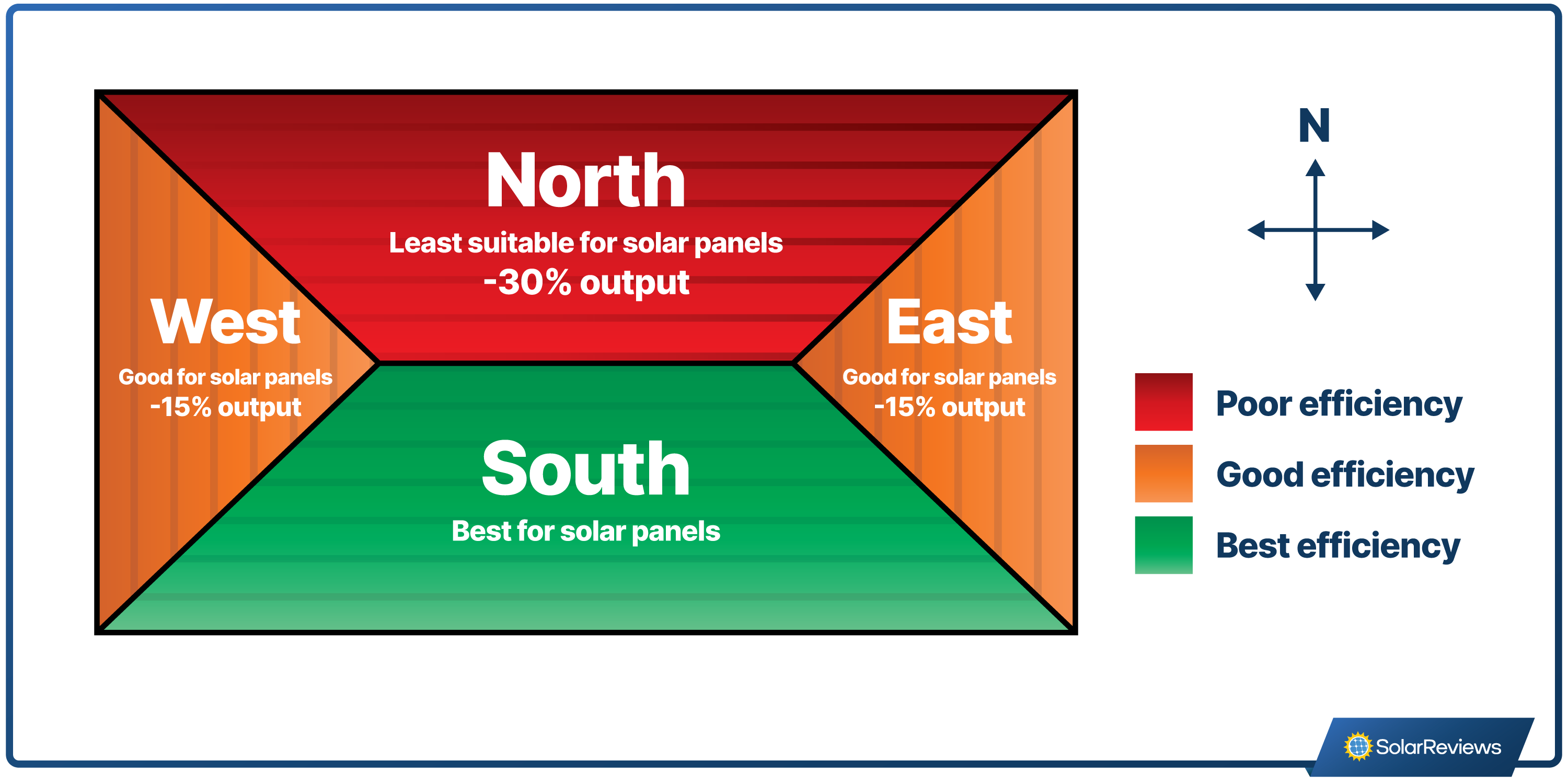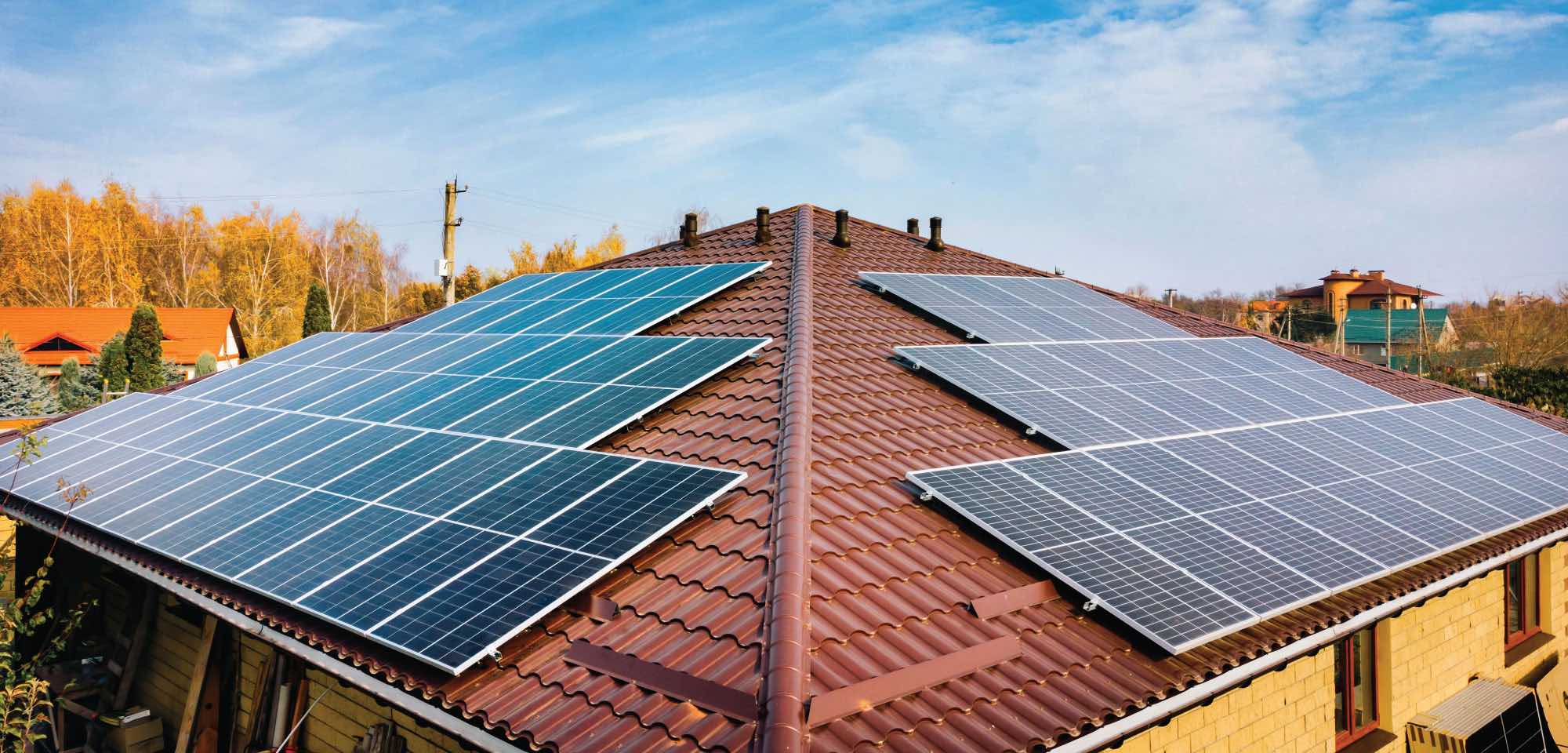Updated 24 minutes ago
The Best Angle and Direction for Solar Panels to Maximize Savings
Written by Dan Simms Dan SimmsDan has been a solar proponent for more than a decade now, and he has been researching and writing about solar and renewable energy for the past five ...Learn more , Edited by Catherine Lane Catherine LaneCatherine has been researching and reporting on the solar industry for five years and is the Written Content Manager at SolarReviews. She leads a dyna...Learn more

Why you can trust SolarReviews
SolarReviews is the leading American website for solar panel reviews and solar panel installation companies. Our industry experts have a combined three decades of solar experience and maintain editorial independence for their reviews. No company can pay to alter the reviews or review scores shown on our site. Learn more about SolarReviews and how we make money.
According to the Department of Energy, the best direction for solar panels to face in the United States is south, as the sun spends most of its time traveling across the southern part of the sky.
Solar panels save you money on your electricity bills by producing electricity for your home to use. How much electricity those solar panels can produce depends heavily on the direction the solar panels face and the angle they’re at. That’s why it’s important to understand the best direction for solar panels.
But does that mean you can’t install solar panels if your roof faces another direction? Let’s take a look at solar panel direction and angle to determine if solar panels are the right fit for your home.
Key takeaways
In the United States, the best direction for solar panels to face is south as it exposes them to the most sun and allows them to produce the most electricity possible.
Solar panels that face east or west will produce about 15% less energy than those installed on a south-facing roof.
A north-facing roof is the worst direction for solar, as panels will produce around 30% less energy than if they face south.
The best angle for solar panels to be installed around 30 degrees, but it ultimately depends on your exact location.
What’s the best direction for solar panels to face?

The best direction for solar panels is true south in the northern hemisphere, including the U.S. These orientations will allow for the most direct sunlight to hit your panels, which helps improve electricity generation and maximizes your electricity bill savings with solar.
Solar panels can be installed on roofs that face other directions, but they will produce less energy than if they were pointing south, and it may require you to install more solar panels to meet your household energy needs. The table below estimates how energy production is impacted by solar panel direction:
Solar panel direction | Achievable output* | Average utility bill savings |
|---|---|---|
South | 100% | $132 |
Southwest or southeast | 92% | $121 |
East or west | 85% | $112 |
North | 70% | $92 |
*As compared to south-facing solar panels; figures are ballpark estimates only.
What factors affect the ideal solar panel orientation?
While true south is generally the best direction for solar panels in the U.S., there are two factors at play that can change that.
Your electricity plan
One exception to the “south is best” rule is customers who live in areas where time of use (TOU) electricity pricing is common. Under time of use rate plans, electricity is the most expensive during peak hours, which usually start around 4 PM, when the sun starts to set in the west.
You could produce more solar electricity during peak times by facing your solar panels south-west. Depending on your utility rate structure, maximizing your solar energy production during peak times could provide higher overall utility bill savings, even if it means producing less electricity overall.

When peak electricity rates are 2x normal rates, the ideal orientation is very close to the south (see left-most image). However, once peak rates rise to 3x or 4x, the ideal orientation changes to the southwest.
The savings you get can also vary with your utility’s net metering plan. Many utilities that require solar customers to use time of use rates only allow excess solar energy generated during off-peak hours, when solar panels tend to produce the most energy, to offset future off-peak costs. However, if your utility company provides kilowatt-hour credits that can be used regardless of when it was generated, you might not have to worry about facing south-west.
Shading
If you do have a south-facing roof but it gets covered in shade by nearby buildings or trees that aren’t on your property, pointing solar panels east or west could provide you with the best energy bill savings.
Solar panels can’t generate power when they’re shaded, so if putting them on the south-roof face would keep them shaded, you’ll lose money. You want the sunniest conditions possible, and while for most homes that’s due-south, it might be different for your particular case.
What if your roof doesn’t face south?
While south-facing roofs in the U.S. are ideal for solar energy production, that doesn’t mean you can’t or shouldn’t go solar if your roof faces another way.
According to data from the U.S. Energy Information Administration (EIA), solar panels on roofs that are tilted 20% to the west from true south will still generate 89% of what a southern-facing roof will. Panels on roofs that face 20% east will generate 85% of those on a roof that’s oriented south.
You may need to install more solar panels to account for the loss in energy production if your roof doesn’t face true south, but solar is still a good option even if your roof orientation is less than ideal.
What’s the best angle for solar panels?
In addition to panel orientation, you should think about the angle of your panels. Ideally, you want the sunlight to hit your panels directly, and you can optimize production throughout the year by choosing the right solar panel angle based on your location. A tilt angle of 30 degrees is generally best in the U.S., but it varies widely.
What factors affect the ideal solar panel angle?
Much like with the ideal solar panel orientation, there are some factors that can affect the optimal angle for solar panels.
Geographic location
A tilt angle of 30 degrees is most common in the U.S., but that varies by location. Areas closer to the equator benefit most from shallower angles, with 18 degrees being best in Hawaii and 24 degrees being best in Southern Texas, Louisiana, and Florida.
A 48-degree panel angle in Alaska is ideal, and 42 degrees is best in North Dakota, Northern Minnesota, and most of Montana. A panel angle between 30 and 36 degrees is best elsewhere in the country.
Roof angle
Your existing roof slope is an important thing to consider with respect to the ideal panel angle. In many cases, solar contractors will install panels with flat racking systems, which means the angle of the panel is just equal to the angle of the roof.
If you have a flat or low-sloped roof, you can opt for an angled racking system to get the perfect panel angle for production. However, some homeowners don’t like the look of these, and the angled racking systems are more expensive.
Alternatively, you can just install solar anyway. Data from the EIA suggests that even panels mounted at a 0-degree tilt on a flat roof can generate 89% of what panels angled to the south will produce. Again, you may need to install a larger system to accommodate your energy needs, but it’s a good solution.
Roof orientation
The orientation of your roof also makes a difference. A 30-degree slope is the most common solar panel angle in the U.S., but that’s only if your roof is oriented to the south. You want your panels to receive as much sunlight as possible throughout the day, so tilting east-facing panels at 30 degrees, for example, will significantly reduce production in the afternoon and early evening.
Why solar panel orientation and angle matter
Together, solar panel orientation and angle determine how much sunlight hits your panels throughout the day and throughout the year, which directly affects how much money they can save on your electricity bills.
If your roof doesn’t face true south or doesn’t allow for the ideal solar panel angle based on your location, you’ll see decreased energy output and savings that could reduce the overall value you get from your solar panel system.
What should you do if you can’t get the ideal panel orientation and angle?
It’s great to have optimized panel direction and angle, but in some cases, it’s just not possible for a rooftop solar system to provide the means of achieving that. Luckily, you have some options.
Install rooftop solar anyway: In many cases, you’ll still get excellent production and efficiency, even if the conditions aren’t exactly perfect.
Install a ground-mounted system: If you have the space for ground-mounted solar, it can be a great alternative if your roof direction isn’t ideal. Ground-mounted solar panels eliminate the issue roof leaks and curb appeal, but they do cost significantly more money.
Invest in a special racking system: Angled racking systems and solar tracking mounts help with your solar panel production, but they’re both uncommon and expensive. According to the EIA, a dual-axis tracking system will provide 132% of the electricity that a static system will, even if the static system is optimized for orientation.
How to choose the best direction and angle for solar panels
You can use online resources to determine what direction solar panels should face and what angle will give you the best rate of production. However, there are other factors at play, like the pitch of your roof, the orientation of your roof, shading on your property, roofs that require installation on multiple faces facing different directions or at varying angles, and more.
Since there are so many moving parts, it’s best to consult with a local solar installer to figure out what’s best for your unique situation. An expert can help you decide if specialty racking is a good option, figure out what angle is best based on your exact location, and even determine if solar is right for you in the first place. They’ll also provide some production estimates for the system they propose so you can see what your expected savings will be if you move forward with their plans.
Dan has been a solar proponent for more than a decade now, and he has been researching and writing about solar and renewable energy for the past five years. He has first-hand experience with solar conversion, and he uses that and his research to help homeowners lower their electric bills and reduce their carbon footprint through solar education and adoption. He has written for major publications, including CNN, USA Today, and EcoWatch, and he has...
Learn more about Dan Simms